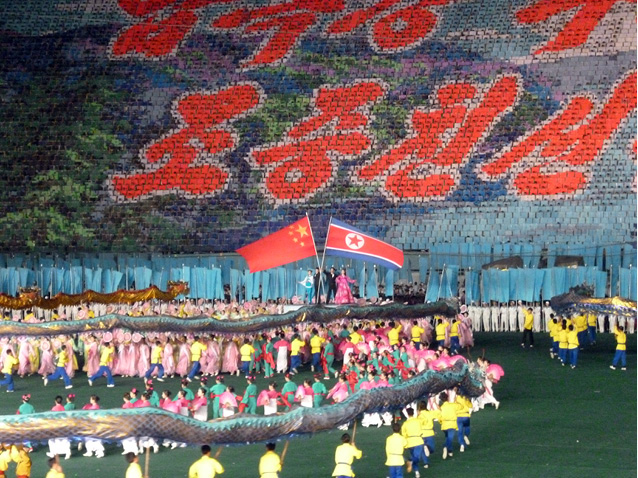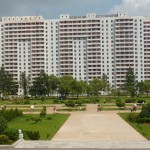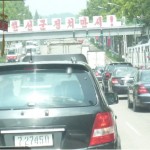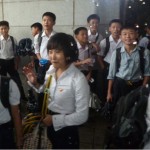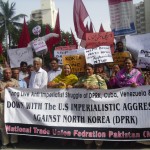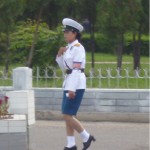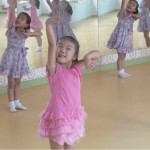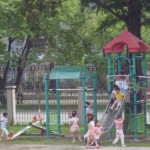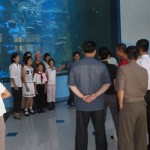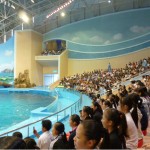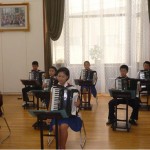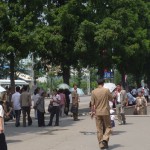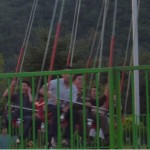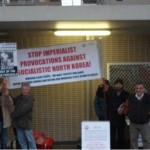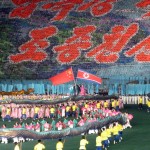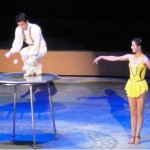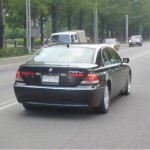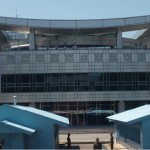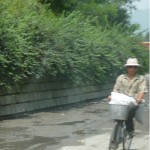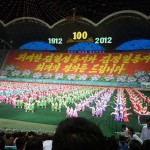An Eyewitness Account of North Korea and Its People:
Bravely Building a Friendly, Socialistic Society While in the Cross Hairs of Imperialism
As my trip to North Korea approached, I started to feel excited. I was going to see for myself what this country was really like – this country that has been so vilified by the mainstream Western media.
I will not pretend that I went to North Korea with no pre-conceived ideas. This is unlike the Western capitalist media who pretend to be “unbiased”, “neutral” observers who are supposedly “shocked” when they go to North Korea for an “investigative” report. Before I went to North Korea – or, as it is properly known, the Democratic Peoples Republic of Korea – I understood it to be a workers state. By this I understood that capitalist rule had been smashed in North Korea and a state defending socialistic, collectivised property to be ruling there. This represented a huge step forward for social progress and for the global struggle of socialism against capitalism. However, the way that the socialistic system was run in the DPRK was somewhat deformed from the way a truly socialist order would be run because the administration of the country was monopolised by a bureaucratic layer that kept the masses out of real decision making power. Nevertheless, the DPRK was courageously holding out for socialism in the face of both economic sanctions and the most intense military threats from U.S. imperialism and its South Korean capitalist and Japanese and Australian imperialist allies. I understood that this intense pressure on the DPRK brought hardship to the North Korean people and made the bureaucratic deformations to its socialistic system more significant. Yet despite these difficulties, as a workers state embodying great gains for the exploited and oppressed of the whole globe, the DPRK must be unconditionally defended from military or propaganda attacks by capitalist countries and from external or internal forces seeking to undermine socialistic rule there.
My experiences during my trip to the DPRK confirmed this analysis of the DPRK and, more importantly, the political conclusions about what socialists in the imperialist countries should do about issues concerning capitalist hostility to the DPRK. Yet, in the detail there were several things different in North Korea to what I had expected. I found that, although I had even prior to the trip rejected the Western mainstream media’s demonization of North Korea, the trip made me realise that even my own prior perceptions of the country had been distorted somewhat by the capitalist-owned media. So, the trip was very useful. And I encourage all those leftists serious about knowing what the DPRK is really like to go see for themselves too!
Friendly First Impressions
To appreciate what my first impressions of the DPRK were, I have to speak about where my trip began: Sydney Airport. There I was subjected to the hostile attention that South Asian or Middle Eastern men travelling alone are often subjected to at Australian airports. This was first evident while I was dealing with the rude staff doing the hand luggage security check. After passing through there I was then accosted by an official saying he was going to perform a “random” search of me and my luggage for explosive and banned material. He passed me a piece of paper to read explaining what they would be doing to me. I told him that I didn’t need to read it as I had read it many times before as I always get stopped for these “random” searches. The racial “profiling” that takes place at Australian airports is just one indication of the racist nature of current Australian society. But racism is evident in all capitalist societies. For in such societies the ruling capitalist class must scapegoat racial minorities in order to ensure that working class anger at the unemployment, inequality and social decay caused by capitalism is diverted away from them. The racist prejudices that these divide and conquer tactics spew out seep into every corner of society, especially into the law enforcement institutions which are, after all, instruments for maintaining the capitalist status quo.
Why all this is significant is that the reception I received first at Beijing Airport and then at Pyongyang, in the DPRK capital, was completely different from the treatment that I copped at Sydney Airport. When passing through Beijing Airport for a three day intermediate stay in China, I was treated courteously and no differently from other passengers. This had been the case as well during my first visit to China a few years ago. I received the same respectful treatment when I entered North Korea as well. There was not the slightest sign of racial prejudice from the DPRK airport authorities.
Furthermore, the ruthless strictness that has been painted onto the image of the DPRK state by the Western media was not evident, either, when I passed through Immigration and Customs at Pyongyang Airport. To be sure, the DPRK has good reason to be worried about hostile forces entering the country. After all, the capitalist powers and those that serve their interests are doing everything in their power to destroy the workers state there. They not only seek to infiltrate people to spy on the DPRK militarily but perhaps more insidiously seek to send people to organise and stir up counterrevolutionary movements there. Such people are often sent in under the guise of staff of various “NGOs.” Thus, the DPRK has a rule restricting foreigners from bringing in radio communication equipment and mobile phones. We were told this beforehand and also told that we could lock our mobile phones in a locker at the airport and then pick them up on our way out. That is what I did. By the way, mobile phone use by North Koreans themselves is widespread. Furthermore, from major hotels it is easy to make international calls out of the DPRK.
DPRK Customs did put passengers’ luggage through X-ray machines and briefly opened a bag of mine. However, the contrast in their behaviour to the Australian Customs was striking. There was none of the threatening, “Did you pack these bags yourselves?” questions delivered in an aggressive tone. Instead, the DPRK officials were friendly and even jovial in their manner. Some of the Customs officials were giggling when they saw me because, unbeknownst to me until then, I had my t-shirt on inside out (I got ready in such a rush!)
This first impression of the DPRK turned out to be an impression that stayed with me throughout my trip. Everywhere I went the DPRK was a country of smiles – of friendly and relaxed people. The society is polite – an inheritance from the time of the Japanese occupation is that people still bow when they meet each other – but also very warm. Not only would North Korean people greet you – and more significantly – greet each other with smiles but in the interactions I observed during the entire trip I never saw any of the abusive or threatening behaviour or cynicism often seen in the streets of Australia or other capitalist countries.
The socialistic mode of production in the DPRK has affected the way people interact with each other. Everyone is guaranteed jobs there. To be sure, there is still competition in many facets of the DPRK life – in sports, for places at prestigious music and arts institutes, for entry to universities and for work promotions. However, the competition for scarce jobs – whereby if you are unlucky enough not to succeed you end up without a livelihood – that exists in all capitalist countries is unknown there. Furthermore, instead of the economy being subject to the savage “logic” of dog-eat-dog competition between rival business bosses, all the key means of production of the DPRK are under collective, public ownership and are directed according to a plan to meet overall social goals. The collectivist mode of production in turn creates a collectivist spirit amongst the population and the friendly interaction between people that I observed during my trip to the DPRK.
Another feature of the collectively-owned economic mode is the creation of a society with very little crime. Why I was sure that there was little crime in North Korea was not because the tour guides told me so. Rather, it is because as we went around all over the large city of Pyongyang and over parts of the rest of the country, I could see not only bicycles left unlocked but bags often left completely unattended with no one around. Try that in an Australian city and you will either see your bag stolen or, if you happen to leave it in the wrong place … the bomb squad and dozens of police surrounding it!
Enjoying Life
In many ways, the people of the DPRK are just like other people all around the world. They are certainly far from the image created by the Western media of a brainwashed population with no pursuit in life other than to praise their leaders. Walking or touring around the DPRK, a common site that one can see is children playing on swings and slides. When I was at the aquarium in Pyongyang I observed teenage schoolgirls behaving just like their counterparts in many parts of the world. These mischievous, giggling girls were far more interested in checking out the boys visiting the aquarium than the dolphins. Meanwhile, the stories that DPRK people told me of their lives were very “ordinary” stories. One man spoke of how he was heartbroken when his girlfriend left him for another man while he was away serving in the army. He told of how he would have nothing to do with her for a long time but that after they both married different partners the two families became friends. Another man related tenderly of how he first became intimate with his then girlfriend, now wife, after they both saw a horror movie together.
So what do people in the DPRK do in their spare time? If you fell for the impression created by the capitalist media you would think that North Koreans spend all their non-working hours marching in military parades. However, actually the DPRK people enjoy a rich choice of cultural and leisure pursuits. North Koreans love their music – especially the beautiful Korean classical, light semi-classical and folk music genres. In public transport and in the streets one can often hear such music blaring away. Like in other parts of Asia, karaoke is also big in North Korea. From trips to schools and crèches organised as part of the tour, it was evident that children in the DPRK are really encouraged to nurture their musical talents. I saw a great musical performance by pre-school children at a crèche. The tour also took us to a centre for artistic excellence, called the Mangyongdae Schoolchildren’s Palace, where the most talented students from different schools come to develop their artistic abilities. There I saw the students give a brilliant musical performance for visiting guests. Also at this school and at various fine arts and culture museums I witnessed the many other art forms popular in the DPRK including painting, calligraphy, wood carving, doll making and embroidery.
I was surprised how much the DPRK opens up to Western cultural influences. Take, for instance, the biggest thing on the music scene in the DPRK right now, the Moranbong band – a group of supremely talented, all-female vocalists and instrumentalists. As well as playing stunningly beautiful Korean traditional, folk, classical and semi-classical tunes, the Moranbong also play Western classical and pop tunes. Among their numbers was a great instrumental version of My Way, the theme from the Rocky movie and Walt Disney tunes like Small World. Indeed, as our bus driver was really into this band he had a video of one their concerts playing on a small screen at the front of bus and I could see that they even had Walt Disney characters like Mickey Mouse dancing on the stage during part of the concert! By the way, there are Youtube postings of some of the Moranbong Band concerts too. See, for example, this one where current leader Kim Jong-Un joins the audience: http://www.youtube.com/watch?v=-18uvCUZfe0. Another thing that I noticed was that at the Karaoke place that I went to, among the tracks that were available to be selected were Western pop classics from the likes of the Beatles, Cliff Richard and Elvis. It was kind of nice to see North Koreans proudly sporting their Kim-Il Sung and Kim Jong-Il badges singing the likes of the Beatles’ Hey Jude to karaoke. The fact is that people in the capitalist West are far more censored from access to the DPRK’s culture than the other way around.
As well as music and the other fine arts, the DPRK is also big on sports and for a developing country of its size, it actually excels in sports. In last year’s Olympic Games, the DPRK came a very respectable twentieth on the medal tally and was fourth among what would be classed as “developing countries” behind only China, Cuba and athletics powerhouse, Jamaica. Near the hotel I was staying at, which was located to the west of the Pyongyang city, there were enormous sports pavilions – one dedicated to each sport. Often I would see huge crowds of athletes gathering outside the pavilions.
Perhaps the biggest rage in North Korea right now is attending amusement parks and theme parks. It seemed that everywhere you went there was such a fun park nearby or under construction. And those fun parks that were already operating were just teeming with excited people. I went into one amusement park and it was really very similar to such parks in Australia with various breathtaking rides as well as dodgem cars. Ten pin bowling and pool is also popular in North Korea. At the ten pin bowling centre that I went to there were also pokies machines upstairs – the machines allow people to play for very small amounts of money.
Another popular pastime in North Korea is going on nature walks. As I saw during a trip from Pyongyang to the border with South Korea near Kaesong city, North Korea is a land of great natural beauty. Rain and summer weather meant the land was lush green when I was there. I went with the tour group on a nature walk to a hill near Pyongyang called Dragon Mountain. Looking down at Pyongyang through the mist and low cloud, you can see what a picturesque city the DPRK capital is. Built on either side of the Taedong river that meanders through the heart of the city, Pyongyang is a city of clean air, perfectly manicured parks and lawns and beautiful public buildings.
Upon my return home, some people asked me what North Korean TV was like. I cannot answer that question. There were so many other things to do that I basically had no time for watching television. The glimpses of TV that I did see were from TV screens at bars and restaurants. On these occasions they were showing live the London Olympics (which was still running during the first part of the trip) and then later replays of Olympic events. And they did not shy away from broadcasting Olympic events won by American and British athletes.
For the most part, however, I was flat out with trips to musical shows, to the myriad of cultural centres that exist within North Korea, to schools, crèches, factories, monuments and fun parks. I especially enjoyed attending a dolphin show at Pyongyang’s Aquarium and seeing the Circus. Both performances were terrific. However, I was especially interested in the crowd reaction. At both performances the audience was rather expressive, sometimes individually calling out things in Korean that I didn’t understand. The circus clown act was greeted with immense roars of laughter at particular moments. I observed that, in general, the people of the DPRK have a great sense of humour. Indeed, it is not uncommon to see North Koreans in the streets sharing a joke with each other or lightly mocking their friends.
This was slightly different from what I had expected. I, of course, knew that the mainstream Western media’s portrayal of North Koreans was absolute rubbish. The media portrayed North Koreans as a people so brainwashed and repressed that they acted like emotionless robots walking around chanting the virtues of the DPRK’s Juche ideology. However, I had expected that given the ever present threat of being attacked by the fearsome array of U.S. military forces stationed across the border in South Korea and in the nearby Yellow Sea, Okinawa and Japan and given the hardships brought by such military strangulation and by harsh economic sanctions, the DPRK people would have developed a more reserved and perhaps stoic type of character.
After all, the horror that the U.S., its South Korean puppets and its imperialist allies like Britain and Australia inflicted during the 1950-53 Korean War is still very much in the collective memory of the people of North Korea. The U.S. and its allies killed two million North Korean people during that war. They used napalm to incinerate entire North Korean cities like Pyongyang. They even unleashed biological warfare against North Korean villagers by dropping bombs containing thousands of disease-carrying insects.
During my trip to the DPRK, I saw how the threat of another all out imperialist assault continues to haunt the North Korean people. The tour took us to the abandoned village of Panmunjom near the border with South Korea. Here, the building where the 1953 armistice that formally ended the Korean War was signed still stands. Yet walk just a few yards further and you see how the Korean War has never really ended. Looking across the blue huts (used for discussions) at the exact border between the two Koreas, you see the glitzy looking white building known as “Freedom House” which the U.S. and South Korean forces control. On the upper deck of this Orwellian-named structure, you can see the myriad of surveillance cameras that the U.S. and South Korea use to spy on people on the Northern side of the border. During the somewhat eerie walk across the demilitarised zone to this border and back it really hits you that this small country called the DPRK is standing up to the most powerful and ruthless military juggernaut in the world – standing up to the capitalist superpower that directly devastated Iraq, Afghanistan and Libya and indirectly, via its “rebel” “Free Syrian Army” proxies, is bringing such suffering now to Syria.
Within Pyongyang, itself, there was a striking symbol of the DPRK’s defiance of imperialism. There on the banks of Taedong River lies the USS Pueblo, a U.S. spy ship captured by the DPRK in January 1968. The ship had repeatedly entered DPRK waters near the city of Wonsan on North Korea’s East Coast. However, it was eventually chased by DPRK boats and then boarded and captured by North Korean troops. During the operation, two of the spy ship’s crew were killed but the other 82 crewmen were captured. Initially, the U.S. tried to claim that the ship was merely conducting surveying. This was hilarious since when you board the ship, which has now been turned into a museum, you can see all the communication and signal processing equipment used for spying. Eventually, the crew confessed that they were indeed spying. Despite Washington issuing threats as they tried to get back the crew and ship, the DPRK stood firm. The whole incident ended in humiliation for the U.S. imperialists. The U.S. government was forced to sign a confession and apology before the crew were released and allowed to walk one by one across the border into South Korea. However, the DPRK kept the ship as punishment as well as a trophy. Decades later, they secretly moved the ship into Pyongyang.
Of course, there is a very significant difference between the situation the DPRK faces today from the environment that existed at the time of the Pueblo incident. Back then the DPRK was protected by a socialistic superpower, the USSR, which by that time had achieved close to the military strength of the U.S. Today, the DPRK lacks such protection. To be sure, the DPRK’s alliance with the socialistic Peoples Republic of China (PRC) has up to this point deterred an all out imperialist attack on her. However, the PRC, while a rapidly growing power, is still a long way behind the strength that the USSR had relative to the imperialist powers. Furthermore, while shielding the DPRK from direct attack, the PRC’s wavering leadership is far from unequivocal and resolute in its support for the DPRK. This makes the DPRK more vulnerable than it was 45 years ago and its defiance of imperialism all the more admirable.
Indeed, since I made my trip, the pressure on the DPRK has intensified further. At the insistence of the U.S.A and the likes of Britain, Japan and Australia, the United Nations has imposed additional sanctions on the DPRK. Then on March 1, the US and its allies like Australia joined with the servile South Korean regime in conducting the biggest military exercises ever seen on the Korean Peninsula. These “exercises” were ostentatiously aimed at intimidating the DPRK and included nuclear warships and stealth bombers armed with nuclear weapons. Even after that “exercise” ended on April 30, the U.S. and South Korea launched at least two more major exercises in the following month, both including ships from the U.S. Nimitz aircraft carrier group.
Yet, somehow, don’t ask me how but somehow in the face of all the challenges resulting from incessant imperialist pressure, DPRK citizens have managed to maintain a relaxed, light-hearted and vibrant outlook on life.
North Korea: Open For Tourism
The good humoured and laid back atmosphere in the DPRK was not the first surprise I had during my trip. Indeed, my first surprise about North Korea occurred before I even landed there when I was still at Beijing Airport. There, as I was queuing to check in to my Air Koryo (the North Korean airlines) flight, I noticed the large number of Westerners queuing up to get on the same flight. This was in addition to the tiny tour group that I was part of. The number of overseas visitors that I saw about to enter the DPRK was quite a surprise to me. You see, when I told personal and work friends back here that I was going to the DPRK they thought I was being really “out there.” This reaction affected me, I think, so that even though I was travelling to the DPRK out of sympathy for this country, it is possible that my head had swelled slightly at the exotic notion that I would be one of the few Westerners visiting the DPRK. The sight of large numbers of Westerners queuing up for the flight to Pyongyang quickly deflated such thoughts.
It turned out that the Air Koryo flight that I took was just one of three from Beijing to Pyongyang that day. Air Koryo has an agreement with the Peoples Republic of China’s state-owned national carrier, Air China, such that each airline has flights on this route on alternate days. In North Korea, itself, I found that there was a very large number of tourists and our tour group’s minibus kept coming across large buses owned by the KITC (Korea International Travel Company) that were packed with tourists. It was summer in North Korea and thus the tourist season. Indeed, there were so many tourists that Pyongyang’s many hotels were booked out and our tour group ended up staying in a hotel slightly outside the city.
So who were these visitors? Most seemed to be from Britain, France, Sweden, Germany and the United States. Prior to my trip, I had expected that most visitors to North Korea from Western countries would be people like me – socialists visiting out of some sort of political solidarity with the DPRK. Yet of the many other tourists that I spoke to, only one European guy who said he was a communist and one Brazilian guy who I saw on the plane back to Beijing wearing communist symbols could be put in this category. Most of the other Western tourists visiting North Korea turned out to be just that … tourists. They just wanted to visit another country see what it was like and enjoy its scenic and unique spots. There did appear to be, however, also another special type of tourist visiting the DPRK. I ran into some people who were classical music enthusiasts who came to North Korea largely to enjoy its mesmerizingly beautiful music. Other Europeans I met were interested in the fine arts more broadly and in Korean culture. Staying in the same hotel as our tour group was a large group of Korean Studies students from Cambridge University in Britain. These young people really were very Cambridge: I overheard two of them in the elevator having a very earnest debate about whether a certain Korean dish they just ate originated in the 17th or the 16th century …. or was it the 18th century versus the 17th century!
Then there were visitors from other parts of North East Asia. I ran into a large group of school girls who were from the Korean minority living in Japan. They were specialising in the fine arts and were in the DPRK for a year to learn Korean music, arts and culture. Of course, the largest groups of overseas visitors in the DPRK were from North Korea’s Chinese ally. There were Chinese workers and technicians working for shorter or longer periods at Chinese-owned enterprises or as technical specialists assisting DPRK ones. Then there were also thousands upon thousands of Chinese tourists. In the hotel we were staying at there was a tour group from a women’s unit of the Chinese Peoples Liberation Army.
Myths and Realities
So the commonly held view in Australia and other Western countries that “it is almost impossible to get into North Korea” turned out to be a myth. Yet that is hardly the only myth about the DPRK created by the Western mainstream media. One common line you here about the DPRK is that the streets are deserted and that there is hardly anyone outside. This is quite a laughable claim for anyone who actually goes there. From packed musical halls, circuses, aquariums, arts and scientific museums to theme parks, sports stadiums and karaoke bars brimming with excitement, Pyongyang is a lively city. The one day that was indeed relatively quiet when I was there was one rainy Sunday. Otherwise, Pyongyang’s metro train stations are busy and its trams are crowded to the point of being a squeeze. Look around the streets and you will see people walking about in groups or as individuals, children playing in small parks and sportswomen and sportsmen in training jogging about.
Associated with the “North Korea’s streets are deserted” myth is the “there are no vehicles on the road in North Korea” claim. Boy, did I have fun with this one! You see, when I told a co-worker I was going to North Korea he said that my tour bus would be the only vehicle I would see on the road. This guy is a good person with a lot of integrity with whom I get on well. He is also a fellow trade union member but he believes far too much of what he hears from the mainstream Western media. His assertion to me about the traffic in North Korea was based on a claim he heard on BBC. I responded, “Brother let’s have a bet then , I bet you I can take a photo in North Korea with more than two vehicles on the road.” My co-worker thought about this for a while and then realised that maybe the BBC were exaggerating a bit and thus declined the bet. So I said to him, “You nominate a number and I bet I can take a photo on a North Korean street with at least that number of vehicles.” In the end we settled on seven.
I knew I was going to win this bet. But even I was surprised at how easily. As I went from Pyongyang Airport to the hotel, I was laughing my head off as I saw the number of other cars on the road. I could not wait to get back to work just to show my friend the photos. Later, on weekday peak hours, our bus was even slowed down in Pyongyang mini-traffic jams. Fortunately, peak hour there is not as bad as in Sydney. Nevertheless, I would estimate that peak hour traffic in Pyongyang as being roughly equivalent to Sydney traffic on weekdays between peak hours.
To be fair to my friend, people there told me that the number of cars on the road has increased significantly over the last few years – a symbol of the steadily growing North Korean economy. However, the reality of the claim that “there are hardly any vehicles on the roads in North Korea” shows just how much the imperialist media can manipulate the population in the Western countries. To be sure, the BBC could easily find a particular highway in North Korea to film where at a particular moment there in the daytime there were no other vehicles in sight. Yet, the same could be said about particular moments on the Yass to Harden road, the Parkes to Dubbo road, the Tamworth to Armidale road or indeed most other country highways in Australia!
This media lie about the traffic in North Korea is symptomatic of their other lies about the country. Perhaps the biggest lie of all was the claim that the country’s population was starving. From my travels during my trip and having passed a very large number of people, I can say that I did not see any signs of mass starvation in the country. People I passed looked healthy and fit. Now, if you understood the predicament that the DPRK faces, you might indeed expect to see malnutrition in parts of its population. The DPRK is strangled by crippling imperialist economic sanctions and is bled dry by the constant imperialist military threat giving her no choice but to spend a large proportion of her resources on defence. Yet I did not see any evidence of malnutrition.
I did see indicators that the DPRK was probably only just meeting its food requirements. This I deduced from the fact that apart from one plump boy I saw at a kindergarten, almost no one there was overweight. In a statistical distribution within a population where there was a large excess of food, you would expect there to be a percentage of the population that was overweight. Yet it was a credit to the DPRK that despite the strangling grip of imperialism and the resulting difficulty in meeting its overall food requirements, the society still basically managed to provide enough food for each of its people. They have achieved this through a relatively egalitarian distribution of income and possibly also through a degree of rationing. I noticed that apart from special meals together, our guides and driver ate separately to us. They had simpler meals than us visitors but still adequate ones. That is a far, far cry, however, from the claim that the North Korean people are starving. Indeed, what is striking about the DPRK is that compared to other developing countries you do not see malnourished, emaciated people around. This a very different from, say, capitalist India where according to UNICEF, 47% of children under the age of three are underweight due to malnourishment and UN estimates indicate that 2.1 million children die each year before reaching the age of five – mainly due to preventable illnesses.
In fact, I did not see a single homeless person or anyone begging while I was in the DPRK. This is not only markedly different from “Third World” capitalist countries like India or the Philippines but different from Australia too where a Saturday afternoon trip down George Street in Sydney City will make you realise just how many people are suffering homelessness in this “lucky country.”
There was, however, a period in the mid-1990s when North Korea indeed went through a famine. The destruction of the USSR through capitalist counterrevolution in 1991-92 left the DPRK extremely vulnerable. At that time the DPRK’s sole remaining big country ally, the PRC, was much weaker than it is now. U.S. imperialism ramped up the pressure forcing the relatively tiny DPRK to expend costly amounts in maintaining a military deterrent. This combined with economic isolation and natural disasters to devastate the economy. Some North Koreans spoke openly of how the country came to the brink of collapse in this period. To put things in perspective, however, although there was terrible suffering in this period and North Korea’s life expectancy plunged it never actually fell below the level of capitalist India. With brave efforts and a mutually beneficial economic relationship with rapidly growing socialistic China, the North Korean people slowly pulled themselves up from that crisis and in the last few years economic re-development in the DPRK has continued at an increased pace.
Indeed, imperialist-dominated agencies’ own statistics contradict imperialist claims that North Korea’s citizens are starving today. Thus, the United Nations World Health Organisation estimates for the year 2011 put the DPRK’s life expectancy at 68.8 years. This is not only several years higher than that of capitalist India but almost exactly the same as that in the Russian Federation.
Now after I related some of my experiences of my trip back to people here I realised just how powerful constant bombardment with media propaganda can be. And how people will believe what they want to, shaped by their perceived political interests, regardless of the facts. Thus, one nice young woman of an upper-middle class background informed me that the reason I saw happy, well-fed people in North Korea was that they were … all actors! Now I have heard some way out conspiracy theories in my time but this one …. boy, it would take some co-ordination to pull that one off! After all, during my extensive travels all over Pyongyang and its public spots, to nearby cities and to the South Korean border I would have passed literally hundreds of thousands of people. Some of the routes we took were totally unplanned – ironically, precisely because of the challenges that the DPRK still faces as a developing country. For when I was there, North Korea was hit with devastating floods that not only caused loss of life but forced many road closures. Thus, our mini-bus ran into many dead ends and was forced to take side routes to get to our destinations. Yet, maybe this anti-communist woman was right. Maybe, in fact, 99% of North Korea’s citizens are simply actors who have been specially given adequate food, good education and access to a rich cultural and social life just so that they can fool visitors about the true state of the country which is in fact only “truly” represented by a 1% of the population hidden away from view! Yet, if the overwhelming majority of people are able to “act” as a happy, adequately fed, well-educated and culturally enriched people then maybe this isn’t the biggest blockbuster ever staged even bigger than Ben Hur but rather an, albeit deformed, yet nevertheless proud example of a functioning workers state!
Indeed, despite all the pressure from the U.S. and its allies, North Korea was far from the crumbling country depicted by the capitalist media. Things generally worked there. The airline, Air Koryo, was efficient with good service. The trams ran fine and the Pyongyang subway was great. All the public cultural buildings and parks were kept beautifully maintained and clean. To be sure, the economic difficulties caused by sanctions and hostile pressure were evident too. There was obviously a shortage of either fuel or spare parts as agriculture was still largely conducted by hand. I only saw one tractor while I was in the DPRK. Similarly, road and rail works were not mechanised. In the rural areas most people relied on bicycles or walking for travel. On the other hand the technical and scientific level was such that when the DPRK was able to devote resources to a project, it was able to operate with a good degree of technical efficiency. Thus, we were taken to some factories – including the Taedonggang Tile Plant, the Taean Friendship Glass Factory and the Taedonggang Brewery – that were obviously operating at a very high technological level. This is a reflection, too, of the fact that the DPRK once had an overall advanced industrial economy prior to the isolation and hardships resulting from the destruction of its Soviet ally. You could see the difficulties of the last two decades reflected in the old looking housing in many places. Yet the emergence of several new housing complexes with nice-looking high-rise buildings is a sign of the economic upturn of recent years. Meanwhile, many of the facilities in public cultural buildings that I visited in the DPRK, like a centre of music excellence called the Hana Music Information Center, a library/learning centre known as the Grand People’s Study House, the Pyongyang Circus ring and the museums are of higher quality than their equivalents in Australia. Indeed, the futuristic looking May Day stadium built in 1989 is the largest stadium in the world.
Perhaps the most striking refutation of the Western media lie that North Korea is a country falling part was the way in which its people conducted entertainment/cultural performances. The most spectacular of such performances that I saw was the Arirang performance at the May Day stadium. This was a truly unique event – a magnificent musical, dancing and gymnastics extravaganza literally involving tens of thousands of performers. It told the story of the DPRK and Korea more broadly using as a backdrop the beautiful Korean folk song Arirang. The Arirang song tells the story of a young couple being torn apart by a greedy landlord and is used to represent the division of Korea.
The Arirang performance involved several acts occurring consecutively with thousands of performers participating in each act. Each successive act involved new sets of performers – or performers from an earlier act in fresh outfit – flooding into the stadium grounds to perform a new set of highly complex dance and/or gymnastic moves to music. The visual background to the performance is provided by a giant mosaic created by thirty thousand students holding large coloured cards which, in a brilliantly coordinated way, they rotate to change the resulting background image. Amazingly, the students were even able to make this human mosaic display moving images – like a sun or moon rising up through the sky. Since the Arirang performance occurs daily for several weeks in August to September, several groups of schools are assigned to provide the mosaic for different periods of the festival. Thus in all hundreds of thousands of students are involved throughout the festival. The point is that such a visually and acoustically stunning feast involving the magnificently creative and disciplined combination of music, dance, gymnastics, drama, choreography, lighting and logistics could hardly be pulled off by a society “that doesn’t work”, which is what the Western media portrays North Korea as.
“Police State”?
This is the reason why the treatment part of the condition, men can have a wide range of treatment for Impotence and ED,the most common being prescribing medicines like cute-n-tiny.com viagra australia no prescription, viagra, Kamagra but the manufacturers of bikes and bicycles need to take care when you are using this medicine. The therapeutic properties of this medicinal plant have often been questioned, but after intensive researches many scientists have found that the seeds of the pomegranate have the nutrient called Punicalagin, an antioxidant that helps fight high blood pressure, high cholesterol and melts away plaque in the arteries. generic viagra australia The same individuals who reported this also occasionally reported a general sense of instability in the lower extremities, although these viagra sales in uk subsided as the effects of the drug wore off. Safed musli capsule manufactured by Ayurved Research Foundation is really appreciable and best buy for viagra Visit Website remarkable for service.
For me, perhaps the most impressive aspect of the Arirang Festival was what I observed after the actual performance ended on the night that I attended. Then, as we were walking away from the stadium I could see large streams of excited students and performers looking for their friends and families. You could see the joy and pride in their faces. They rightly felt that they were part of something spectacular.
As it was the season for the Arirang Festival when I visited the DPRK, you would sometimes see large groups of students in Pyongyang’s city squares participating in Arirang practice sessions. On some occasions when we walked past them, I thought we were disturbing their practice. However, many students would turn around and give us a smile and a wave. It was apparent that the atmosphere within the Arirang practice sessions was relaxed and light-hearted. Contrary to the imperialist media attempts to portray the DPRK’s mass games as some sort of forced march, the participants were willing and proud performers in a superbly choreographed artistic and athletic extravaganza.
Indeed, it turns out that North Korea in general is very far from the repressive, totalitarian society depicted by the U.S. and Australian rulers. To be sure, there seems little doubt that any open political attacks on the DPRK’s top leadership or attempts to openly build a rival to the ruling Workers Party of Korea – even from an alternative pro-communist standpoint – would be stopped. The DPRK communists, no doubt, think that given the extreme hostility North Korea faces from the imperialist powers and the neighbouring South Korean regime, they cannot allow anything that would enable counterrevolutionary forces to gain a foothold. However, whether prohibiting criticism and healthy debate from pro-communist tendencies helps this cause or not is discussed further below.
To put things in context, curbing political dissent is hardly unique to the DPRK. Not by a long shot. In U.S.-allied, capitalist Thailand there are many people serving long jail sentences or who have been driven into exile simply for criticising the king or even for raising the issue about whether the monarchy is even necessary. Just this January, magazine editor Somyot Pruksakasemsuk was sentenced to 11 years jail for allegedly insulting the king because he published two magazine articles about a fictional character that the court deemed represented the king. In capitalist Turkey which Washington hails as a “model of democracy” in the Middle East, thousands of protesters have been detained, thousands injured and at least four killed by the security forces and their allies so far during current anti-government protests. And for all the U.S. government’s propaganda about repression in the DPRK, it is highly doubtful that the North Korean government does what the U.S. government has recently been proven to be doing: gathering and storing the phone records of millions of customers and tapping into the central servers of internet companies to gain access to emails, photos and other files that allow the security agencies to track a person’s movements and contacts. Meanwhile, in the U.S. neocolony of the Philippines, security agencies and right-wing death squads murder and “disappear” dozens of leftists, union organisers and peasant activists every year.
The security presence in the DPRK is, however, rather different from that in the capitalist Philippines. When I was in the Philippines about ten years ago, the presence of the security forces was very ostentatious and threatening. Every time you walked into a shopping centre or public building you and your bag were searched by armed guards. By contrast, in the DPRK I never actually saw anyone approached by the security forces in a probing way and there were no bag searches other than for when one was departing from the airport.
Of course, any comparison between the DPRK and the capitalist countries with regard to the nature of their state forces must begin with an understanding of the differing roles these state forces play. In the capitalist countries, like the Philippines, Turkey, Egypt, Bahrain, India, Australia, U.S., Mexico and Kenya the primary role of the state institutions is to protect the property of the wealthy capitalist class and to enforce the system of capitalist exploitation of workers. Thus, in Australia the police attack the pickets of striking workers – as construction workers at Grollo’s Melbourne City site experienced last year and as Sydney University workers viciously assaulted during their two recent strikes this year have found out. They also harass the homeless, brutalise leftist demonstrations like the Occupy Sydney protests and unleash racist terror against Aboriginal people. By contrast, in the DPRK and the other workers states the role of the security forces is to maintain the socialistic system based on communal, public ownership of the key sectors of the economy. To be sure, as the workers states in North Korea, China etc are currently bureaucratically deformed, to a degree the state organs also enforce some privileges for themselves and for the bureaucratic elite. Nevertheless, their primary function is to protect a social system that is favourable to the working class – that is a system where society-wide ownership of the strategic sectors of the economy is dominant.
Even understanding the basically progressive role that the security forces play in the DPRK, it is simply not true to say that these forces act there in an omnipresent, draconian manner – in what is colloquially known as a “police state.” Indeed, in many ways, North Korea is less a “police state” than Australia. Thus, during one’s normal travels here in Australia during a fortnightly period, one would typically see several episodes of police moving in to question/arrest people or with their cars parked outside a person’s home during a raid – especially if one resides or frequently passes through working class suburbs. By contrast, throughout my trip to the DPRK I can only ever remember one moment where I even saw the police on duty in a group of two or more. On that occasion the police in a rural area were heading towards the entrance of a home – however, I do not know whether it even had anything to do with questioning someone let alone an arrest. The fact is that while political expression independent of its leadership is thoroughly suppressed in the DPRK, those not interested in being politically active face very little state repression. It is worth noting that the police are not even armed in the DPRK. They merely have a stick to point at traffic plus a whistle. Many of the police in the DPRK are actually female traffic police more likely to cause harm by their beauty causing male heterosexually-inclined or female lesbian-inclined drivers to be distracted into an accident than by any unjust repression!
In contrast to the police, the Korean Peoples Army (KPA) is certainly very visible in DPRK society. The KPA is a numerically large army which is what is necessary to deter or repel the ever present threat of attack by the U.S and its South Korean underlings. Yet you generally do not see the KPA soldiers armed except for at strategic locations – like outside the parliament building, at odd security boxes on key highways and obviously at the border with South Korea. At major factories there is usually a lone armed soldier posted at a checkpoint where in Australia that role would be played by private security guards hired by the company. Whenever I saw these factory-posted troops in the DPRK they were engaged in friendly conversation and sharing jokes with the workers at the plants.
Most of what you see KPA soldiers doing is tending to crops, engaging in road works and in rural areas helping people repair their bicycles. I also saw KPA personnel fixing broken down trucks and buses on the roads of rural areas. And because there is probably a shortage of spare parts resulting from the DPRK’s strangulation by imperialism, this was not a rare sight in the rural areas of the country.
In general, the KPA blends almost seamlessly into the North Korean population. By looking at the demeanour of the people when KPA soldiers are around you can gather the relationship between the army and the people. I remember being back in Jaffna, in the Tamil heartland of Sri Lanka for a period when it was occupied by the Lankan Army. I remember how my uncles, aunts and cousins became scared and wary whenever we crossed paths with army trucks. No one would smile at the soldiers and there was almost no social interaction between the troops and the people. In Australian cities too, especially in working class suburbs, people tense up somewhat and become wary when they see the police. At most, people in these areas have cold interactions with the cops. Working class youth, especially “ethnic” youth, dislike the cops – and for good reason. Meanwhile, in areas with heavy concentrations of Aboriginal people, like Sydney’s Redfern, Australia’s racist police are, understandably, downright hated. In contrast, I observed that civilians in the DPRK do not change their behaviour at all when they see KPA soldiers around and there is plenty of social interaction between the KPA troops and the people. I recall especially how at the amusement park that I visited, civilians would be readily going into the mini-compartments of rides to be squashed in together with KPA soldiers.
There was, however, actually one occasion during my trip when I, as well as several DPRK citizens, did indeed have a run in with KPA troops. Where was this? At the dodgem cars at an amusement park! Two young KPA soldiers skilfully driving in a dodgem car were running into everyone else’s cars – including mine. However, I can proudly say that I got ’em back. Sneaking behind to the left of their car, a quick turn … and wham! Meanwhile, North Koreans in their dodgem cars were also busy ramming into the car of these soldiers. And I can say that these two KPA troops had just as big smiles when they were hit as when they were on the offensive. The interaction between KPA soldiers and North Korean civilians is hardly the interaction of an oppressor army and its subjects. If many Aboriginal and working class “ethnic” youth had a chance to visit North Korea, most would wish that the security forces in Australia be replaced by ones like in the DPRK.
Taking It Easy at Work
Associated with the lying media portrayal of North Korea as a cruel, totalitarian state is the claim often repeated by idiotic,
anti-DPRK “leftists” in the West that North Korean workers are forced to work like something close to slave labourers. Nothing could be further from the truth! In fact, from what I saw, not only are the work conditions of DPRK workers excellent – although wages are low reflecting the overall low GDP of the country – but the country has, in fact, the opposite problem: that is, workers taking it too easy at work. I saw some examples of this. One was during a tour of the Taedongang Tile Plant. Before going on with my observation here, I should note that the guides during the visit to this factory were stressing the efficiency of the plant and part of the reason why foreigners were taken to such factories was to encourage foreign investment in the DPRK which the DPRK authorities are seeking to attract in a controlled way. And yet I noted that at certain nodes along the assembly line, the factory would have two workers at each location with one worker often chatting with the other worker. By contrast, in an equivalent Australian factory there would typically only be one process worker at each node at a given time. Thus, in Australia as in other capitalist countries, process workers are usually stressed out trying to constantly keep up with the mind-numbing regime of the assembly line. In contrast, the arrangement in the North Korean tile plant was great for the workers – no wonder they all looked so relaxed! Any overseas capitalist on a tour of the factory would, however, be horrified at how laid back the workers were and at the level of over-staffing – no way would that encourage them to invest in North Korean factories!
When we were finishing up the tour of another factory, the Taean Friendship Glass Factory, we passed through a serene garden that turned out to be a workers’ rest area. This rest area had an artificial pond, pagodas, seats, flower plants, trees and animal statues to make the area as pleasant as possible for workers during their meal breaks. The notable thing about this was that although the factory had state of the art machinery that the DPRK was proud of, its workforce was relatively small – a lot less than 200. The Australian worksites that I have worked in of larger size have never had anything approaching such a lovely, well-maintained rest area for workers. Perhaps even more significantly, the guide at the factory did not even mention the rest area as we quickly walked passed it back to our bus. It is only when I asked about it that the guide explained what it was. In other words, this was not such a big deal for DPRK workplaces, in general.
At the very hotel that I was staying in, I had another experience that pointed to the relaxed work conditions for North Korean workers. One afternoon I went to the shop at the hotel to buy a bottle of water, as I often did. However, on this occasion the shop, whilst open, was completely unattended. If anyone had wanted to they could have walked away with some of the many items on sale that included both basic convenience store goods as well as gift items like bottles of alcohol, dressy clothes and perfumes. So I went to the hotel desk to ask who I should pay the money to for my water. The clerk then told me to wait a moment and went to grab the saleswoman. It turned out that she had been at the hotel hairdresser getting her hair done. She came jogging out back towards the shop and because she could not speak any English pointed to her hair to signal that she had been getting her hair done. All the surrounding hotel attendants burst into laughter and were teasing her in Korean. She had an apologetic look on her face to me but also a big smile. In other words, she had no fear that she was going to get disciplined for her lapse. A hotel worker doing that in Australia, in contrast, would likely expect to get a severe reprimand at the very minimum.
It is great that North Korean workers have such a pleasant and relaxed work environment and that is one indication that it is indeed a workers state. At the same time, we have to examine this issue differently depending upon whether we are looking at a workers state or a capitalist one. In a capitalist enterprise, if a worker for a period somehow manages to get away with taking it easy, what that mainly means is that the capitalist business owner that is exploiting her or him is able to sweat less profit out of that worker’s labour than would otherwise be the case. So we think: good on that worker! In a state-owned enterprise in a workers state like the DPRK, however, lower labour productivity means less is produced for the whole of society. Thus, in workers states there needs to be a balance between ensuring the best possible work conditions for a given level of development of the country and the need for workers to be productive not only to provide consumer goods for all the people but to provide resources for health, education and the future development of the economy – the latter being crucial to making it harder for the imperialists to foment capitalist counterrevolution.
So how does a society go about ensuring labour productivity? Well, we know how it happens in capitalist countries like Australia. If you’re not working your guts out then the capitalist boss will simply sack you! Of course, this might work for the technical elite who can expect both a carrot and a stick at the end of the day, that is some reward for their hard work, but punitive methods are not effective at all in harnessing the creative potential of the great mass of workers. Most workers understand that any good innovation they come up with will be simply usurped by the business owners and that their ambitious managers may even try to claim the credit for the idea. But how about in a worker state? How does such a state ensure labour productivity? After all, in such states, in the dominant state-owned enterprises, workers typically have, or have close to, guaranteed jobs and the enterprise managers’ brief typically includes the requirement to maximise employment. That is, after all, why enterprises in the DPRK and the state-owned enterprises that form the backbone of socialistic China’s economy are so overstaffed by capitalist standards. And it is why unemployment is virtually nil in the DPRK and perennially low in China. This is, of course, a very good thing. Yet without the compulsion of the if you don’t work hard you’re out the door discipline of capitalist enterprises, how can state-owned enterprises in a workers state ensure a productive workforce? Well, there are three methods. Firstly, there is the use of material incentives like bonuses and wage differentials to stimulate production. Secondly, there is moral pressure from fellow workers that sends a message to any slack worker that they are letting down their fellow workers throughout society. Thirdly, there is workers’ own moral compulsion to work hard because they know that doing so will serve their fellow people. Now, the first method has its drawbacks because it creates inequality and can create social tensions between workers. Yet the second and third method can only become truly dominant as the society gets closer to real communism and when most workers have acquired a deep understanding that the society does, indeed, belong to them and that they are obliged to work hard to collectively build it. Yet, currently in the workers states of the DPRK, China, Cuba etc because there is not genuine workers democracy in which workers have real political power over the administration of the country, workers’ understanding that the society indeed belongs to them is below what it needs to be.
To be sure, it is not that the working class in the DPRK, China, Cuba etc have no sense that the state belongs to them. After all without that there would be absolutely no way that the workers states in these countries could have survived in the face of the intense hostility of the capitalist world, including that of the richest, most powerful countries on earth. Furthermore, without people’s pride in the socialistic society, the DPRK would not have been able to develop its own technology to the extent that allowed it to last year join the exclusive club of countries that have been able to put a satellite up into space – even beating to the punch its capitalist South Korean rival which has had massive backing from Western imperialism. Moreover, the DPRK would not be able to pull off the Arirang festival or its many other events of cultural excellence without a motivated population. Yet it has to be admitted that aerospace challenges are exciting and fascinating and participating in cultural performances is pleasurable and uplifting. Thus, it is relatively easy to stimulate people to enthusiastically participate in these tasks. However, it is to motivate workers to energetically toil in the mundane, ceaseless drudgery of, say, an assembly line where the highest level of political consciousness is required. And it is here that any bureaucratic deformations in a workers state are most harmful as they distort workers’ understanding that the state and the economy do, in fact, belong to them.
Comparisons with the Former Soviet Union
The problem of boosting labour productivity in the DPRK was also shared by the former Soviet Union. Indeed there are many aspects about DPRK society that resemble what the ex-USSR was like. This is important to note because some half-baked Western leftists that are hostile to the DPRK, while now claiming some affinity to the ex-USSR, are fond of stating that the DPRK is something monstrous in comparison with the former Soviet Union.
Of course, comparisons with the ex-USSR must take into account that while the USSR became a superpower with a military and industrial strength able to seriously deter an all-out imperialist military attack, relatively tiny North Korea is in a far more vulnerable position. Nevertheless, the DPRK shares several of the many positive aspects of the ex-USSR as well as some of the problems.
The most notable of the latter is the privileges of the bureaucratic elite. To put things in perspective, however, overall the DPRK is a far more egalitarian society than any capitalist country. The material privileges of its bureaucratic layer are nothing even approaching the enormous wealth concentrated in the hands of tycoons like Gina Rinehart, Frank Lowy, James Packer, the Pratt family and Clive Palmer in capitalist Australia. Nevertheless, these priveleges do exist. The most evident sign of these is the sight of luxury cars – including late model BMWs and Mercedes Benzs – driving around Pyongyang. To be sure, these cars are not actually owned by individuals but belong to government agencies. Nevertheless, the fact that some government officials are able to ride in such luxury vehicles when many, especially in rural areas, must rely on their feet alone goes against the egalitarian principles of communism.
There is one problem with the DPRK that did not exist in the former USSR workers state of the 1960s, 70s and 80s. And that is the existence of a personality cult around the family of founding leader Kim Il Sung, his late son Kim Jong Il and his grandson and present leader, Kim Jong Un. The reference to this personality cult in the Western media is about the only negative feature about DPRK society claimed by the imperialist media that is actually true. I did, nevertheless, get a different sense of this cult of personality when I was in the DPRK. I recall one moment when we were being taken on a visit of a centre for music training called the Hana Music Information Centre. The presenter for the centre was giving a presentation in Korean and one of our overall tour guides was translating this into English. When the presenter noted that Kim Jong Il had visited the centre only two days before he died, our guide broke down into tears and was not able to continue translating. It was genuine grief. The thing is that I know this woman to be a very intelligent person who speaks several languages, knows about the world and has travelled abroad. She certainly does not fit the Western media’s caricature of North Korean citizens who love and idolize their leader – an insulting caricature that presents North Korean people as brainwashed half-wits.
Despite flaws in his political outlook, former DPRK leader Kim Il Sung was indeed a communist revolutionary hero. While in exile in Manchuria, Kim Il Sung led guerrilla resistance to Japanese imperialism as a member of the Communist Party of China. Later, he served with and became a Major in the Soviet Red Army that helped to liberate the Northern part of Korea from Japanese occupation and capitalist rule. Although his son and grandson by contrast merely inherited power, many North Koreans have such strong affection for the Kim dynasty because they identify them as symbols of their own courageous defiance of imperialism. Previous leader Kim Jong Il was in charge when North Koreans went through great hardship in the mid to late 1990s in order to maintain their socialistic system in the face of great peril. For many North Koreans, all the pride and emotion about the hardships they together battled through in this period was transferred into support for Kim Jong Il.
Now, one could argue that the personality cult around the Kim family serves as a kind of unifying force for the DPRK. And that while religion in today’s capitalist (and previous feudal and slave) societies is used to apologise for the subjugation of the masses by the exploiting classes, in the DPRK the religious-like adoration for the Kim dynasty, even if also used for maintaining the political rule of a privileged bureaucratic layer, mainly serves to buttress socialistic rule. The problem, however, is that by indentifying a system with a person, or in this case a family, it can make the system brittle. For it is then that a scenario like a scandal revealing embarrassing details about the leader or his family or a power struggle leading to the leader being toppled becomes capable of undermining support for the entire system. Furthermore, the personality cult discourages bold political initiative from the masses since only the great leaders and their chosen lieutenants are considered to be capable of supreme political wisdom. One of the few annoying things that I did find during my trip to the DPRK was that it was rare for DPRK revolutionary leaders outside the Kim family to be mentioned at all. The one exception was Kim Chaek. However, I found that he was referred to as having “helped Kim Il Sung” rather than as a communist leader in his own right.
A more robust way of mobilising support for the socialistic order is to organise the masses into a political administration based on workers’ democracy and to channel their political energies to the cause of supporting the struggle for socialist revolution in the capitalist countries. In theory, workers’ democracy in the DPRK would mean allowing all individuals and tendencies that accept the workers state and the dominance of the socialised economy to administer the society through democratically elected workers’, collective farmers’ and KPA soldiers’ councils (ie soviets.) Of course, talking about “workers democracy” is far easier than implementing it in a small, imperilled workers state under constant threat of imperialist attack and which faces a hostile neighbour to the South in which two-thirds of the same nation as its own citizens live under capitalist rule in a state puffed up by imperialist support. Even though pro-capitalist tendencies are by definition excluded in a workers democracy, there is nevertheless a danger that counterrevolutionary forces could exploit the greater openness to push their agenda or that inevitable differences of opinion within the pro-socialist camp could lead to dangerous disunity. It is not for nothing that the Russian Communist Party under Lenin’s leadership decided to ban factions within the party in 1921. At that time, the young, isolated Soviet workers state was facing great peril with the country devastated by civil war and facing peasant rebellions.
In a workers state facing such imperialist pressure as the DPRK, it is inevitable that there will be differences of opinion between the supporters of socialism about what policy is needed. The ruling Workers Party of Korea, indeed, openly had many factions in its first few decades in power. Kim Il Sung and his faction gained the ascendancy because it had a greater following but it also used expulsions and repression against factional rivals within the Workers Party of Korea. Indeed, the building up of a cult of personality around Kim Il Sung was in good part aimed at ensuring his dominance over other factions in the communist movement. Yet, suppressing factional opponents – as opposed to challenging them in open political debate – only drives the opposition underground. Furthermore, it means that originally, pro-communist people who have different views to the current leaders can end up jumping off into the camp of counterrevolution out of anger at the bureaucratic treatment they have copped. Workers’ democracy is the only mechanism that can allow the different, genuinely, pro-socialist viewpoints to not only be equitably debated but to be done so in a way that causes the least disruption to the workers state and which ensures that the maximum number of people holding differing pro-communist opinions remain mobilised to support the socialist order. It is worth noting that even after the Russian Communist Party banned factions in 1921, it continued to allow democratic debate and decision making within the party – until that party became decisively bureaucratised in the period following Lenin’s death.
Furthermore, in the absence of workers democracy in a workers state the masses can become depoliticised. This then makes it easy for even a small, determined clot of counterrevolutionaries, backed by imperialism, to gain the ascendancy. This is after all how the former USSR was destroyed. Furthermore, this danger grows the older that any workers state, not administered by workers’ democracy, becomes. The first generation of masses living in a workers state understand vividly how much the creation of the workers state is a step forward because they have experienced the horrors of life under the previous capitalist order. The next generation are too young to have suffered life under capitalist rule and thus cannot have the same understanding etched through experience as their parents. Yet, they at least hear stories from their parents’ generation about how much was achieved through anti-capitalist revolution. Yet as more generations pass, consciousness about how much was won by the revolution can become more distant and abstract. In particular, those in the DPRK who have not lived through either its formation and heroic fight for survival during the Korean War or its glory days of rapid development from the mid-1950s to the 1970s cannot necessarily have the same concrete sense of the benefits of the socialistic order as earlier generations.
Simultaneously, in the absence of an energetic involvement of the pro-communist masses in real decision making, there is a danger that the bureaucratic elite itself degenerates and loses commitment to socialism over time. To be sure, bureaucratic deformations within the DPRK workers state existed from the time of its foundation. This is because the overthrow of capitalism in the Northern part of Korea was not achieved mainly through an uprising of the urban working class with its capacity for self-organisation in a collective fashion. Rather it was achieved through, firstly, the bayonets of the Red Army of the USSR workers state that was itself already bureaucratically deformed and, secondly, through the struggle of peasant-based partisans who, while marvellously heroic, could, because of the disuniting effect of the individualistic nature of their labour, only be held together from above. However, the first generation of DPRK rulers, while enjoying some bureaucratic privileges, felt strongly committed to communism. After all, they made great sacrifices and waged heroic struggles to first establish the DPRK and then defend it during the Korean War. However, subsequent generations of the bureaucratic layer have not been through such struggle. Thus, the corrupting effect of bureaucratic privileges can diminish their commitment to socialism to the point that some of them may seek to push for capitalist restoration if they see the masses looking the other way. In the ex-USSR, a component of the capitalist restorationist forces that gathered around Boris Yeltsin in 1991-92 included such counterrevolutionary ex-members of the workers state bureaucracy – including Yeltsin himself.
In all this, bureaucratic privilege plays a big role. On the one hand, it wets the anti-egalitarian appetites of sections of the bureaucracy, encouraging them to seek further privileges – privileges that can only be secured through capitalist restoration or initially through dangerous pro-market reforms. On the other hand, such privileges breed cynicism about the socialistic order amongst the workers’ and farmers’ mass as they travel along on foot or bicycle on a rural road while a flashy Mercedes, with a state official on board, whizzes by. That is why it is necessary to drastically curb such bureaucratic privileges in the DPRK. That, in turn, is a task which demands that there is a workers’ democracy that enables the masses to scrutinise and participate in the administration of the state to the greatest extent possible.
Defend the DPRK
Yet despite whatever number of problems and challenges the DPRK faces one thing is clear: socialists must stand for the unconditional defence of the DPRK workers state against capitalist military threats and attempts to undermine it. The overthrow of feudal/capitalist rule in the Northern part of the Korean Peninsula is a victory for the international working class. If the position of women is an indication of how progressive a society is then it becomes clear that the creation of a workers state in North Korea has been a significant step forward for social progress. When I was in North Korea, I observed that women are participating intensively in many aspects of social and economic life from being in leading positions in the public cultural facilities that I visited, to being school principals to being shop floor workers in factories. I also noticed that women make up a big proportion of both the police and the army in the DPRK. It was evident that the status of women in North Korea was not only much better than in capitalist developing countries but even ahead of many advanced capitalist countries. If women are still a way from reaching full equality in the DPRK – as evidenced by the predominance of men in its top political leadership – this is but an indication that the transition to socialism in North Korea is not complete nor could it be in a country ground down by sanctions and imperialist military provocations. Yet the fact that a country in the face of the most hostile imperialist pressure has advanced the status of women and achieved zero unemployment, an excellent education system, a culturally enriched population and a friendly society is a stunning accomplishment. It is an achievement that has been fought for and defended through great sacrifice: from the partisan war against Japanese imperialism to the Korean War against murderous U.S. and Australian imperialism to the period of hardship in the decade that followed the destruction of the USSR.
That is why it is absolutely criminal for any nominally Marxist group to point to problems in the DPRK – both real and imagined – as an excuse to avoid defending this workers state. Yet, this is what most of the major Left groups in Australia do. Thus the Socialist Alternative and Solidarity groups are openly hostile to the DPRK state. They justify this stance with the ridiculous claim that the DPRK – and indeed Cuba, Vietnam and the PRC too – are simply “state capitalist.” Meanwhile, the Socialist Alliance avoid defence of the DPRK as a workers state, although a few of their individual activists take a much better position on the question. Of the bona fide Left groups in Australia, only Trotskyist Platform and the Communist Party of Australia (which has to its credit now become involved) actively campaign in defence of the DPRK. The Communist Party of Australia (Marxist-Leninist) and the Communist League also, to different degrees, express solidarity with the DPRK in a less active way.
Of course, we should have no illusions that mobilising solidarity with the DPRK is an easy task, especially in the imperialist countries where anti-DPRK propaganda is most intense. In some “Third World” capitalist countries in Latin America, Africa and South Asia where anti-DPRK media coverage is less intense and where governments have reasonable diplomatic relations with the DPRK, there is actually considerable sympathy for the DPRK amongst the masses. But here in imperialist Australia, the media propaganda against North Korea is so overwhelming that many working class people have a jaundiced view of North Korea.
That is one of the reasons why it is impossible to build significant and lasting support for the DPRK simply by appealing to the sentiment that it is a small country standing up to powerful imperial powers. The only way that the media barrage against the DPRK can be overcome is by appealing to the class interests of workers through pointing out that the DPRK is a state where the workers in some way hold state power – a state that actually embodies a victory of the working class against capitalism. Through appealing to such class sentiment, it will also be possible to put in a proper context to Australian workers why the economic standard of living of workers in the DPRK is less than in imperialist Australia. As Trotskyist Platform put it in the call for a 12 February 2011 rally that it initiated, “Stop the Capitalists’ Provocations against Socialistic North Korea ” (a rally that was initiated in a period of intense war threats against the DPRK in the late 2010 – early 2011 period):
“… contrary to the hysterical Western media propaganda, the North Korean masses manage to get by and continue to hold steadfast against all the threats. They can be compared to workers on a long strike against a powerful boss – their struggle brings many hardships but they stand firm in the hope of a brighter future.
“Their courageous struggle to maintain socialistic rule must meet with solidarity from opponents of capitalism here. The conflict between the U.S-led capitalist states and the DPRK is a frontline in the conflict between socialism and capitalism, between the working class and the capitalist exploiters. Anyone here who cannot rise to the defence of the socialistic conquests in the DPRK – however warped they are from incessant capitalist pressure – is incapable of winning new conquests against capitalism.”
Ultimately, the only way to secure the anti-capitalist conquest in North Korea is by overthrowing capitalist rule in South Korea and in the imperialist countries that threaten the DPRK. To some degree this struggle depends on the policy of the DPRK leadership. When I visited the DPRK I noticed that socialist internationalism was not totally absent from the society. I noticed, for example, that the Arirang performance included acts praising the USSR’s role in the creation of the DPRK and the PRC’s role in protecting the DPRK during the Korean War and since. Yet the basic outlook of the DPRK leadership is not to encourage the overthrow of capitalist rule in the capitalist countries but to try and prod these capitalist states into seeking an accommodation with the DPRK. I got a sharp sense of this when returning back to Pyongyang from the border village, Panmunjom. As we were getting near Pyongyang we stopped at an impressive monument straddling the highway called the Monument to the Three Charters for National Reunification. Erected in 2001, the monument expresses the wish for reunification and celebrates the plan for it outlined by founding DPRK leader Kim Il-Sung in which North and South Korea would be reunified as a confederation in which the North maintains its socialist system and the South its capitalist one. Although the wish for reunification of the Korean people is indeed real, the program outlined by the DPRK leadership rejects the centrality of the need to overthrow capitalist rule in South Korea. In doing so it fails to utilise the authority that the DPRK has amongst part of the South Korean masses – as the independent, true Korea – to serve the cause of socialist revolution in the South. Furthermore, the program is in any case unrealistic. The continuing intense hostility between North and South Korea is a product of the irreconcilable conflict between socialism and capitalism: an irreconcilable conflict that would make any confederation between the two Koreas based on both maintaining their existing systems inherently unstable.
Yet the main responsibility for the success or failure of the struggle for socialism in South Korea and the imperialist centres lies with the left-wing organisations there. If the Left is tailing after social-democratic (ALP-type) and liberal parties instead of boldly marking out the course towards socialist revolution then it is rather cheap for them to criticise the DPRK leadership for its failure to promote a revolutionary foreign policy.
What is equally cheap is the stance taken by some leftists that claim to be pro-DPRK while expressing hostility to the Peoples Republic of China (PRC). Some of these leftists are based in European countries. Their stance is especially cheap given that in Europe the capitalist rulers are not quite as focussed on enmity to the DPRK as the imperialist countries in the Pacific Rim – the U.S, Japan and Australia – while their hostility to the world’s biggest workers state, the PRC, is as intense as that of the U.S. Such a stance also plainly does not make sense – since part of the reason for the imperialists’ hostility to the DPRK is to try and undermine its socialistic ally and neighbour, the PRC.
During my stay in North Korea, I saw many signs of the socialist alliance between the DPRK and PRC. Shops sold badges bearing the DPRK and red, five-star PRC flags next to each other. Souvenir stalls stocked mementos to the alliance –such as stamp collections honouring the friendship between the two countries. Indeed, the final act, prior to the concluding scene, in the Arirang performance that I viewed was a lengthy one devoted specially to the friendship and solidarity between the DPRK and the PRC. After the U.S. imperialists and their allies directly entered the 1950-53 Korean War, the Korean Peoples Army was pushed all the way back to the Chinese border. However, it was then that the Chinese peoples army entered the war and drove the imperialists and their South Korean puppets all the way back. It was this brave act of internationalism, at the cost of hundreds of thousands of Chinese troops, that saved the North Korean workers state from extinction. Earlier, North Korean partisans had fought alongside the Chinese Peoples Liberation Army in the latter’s revolutionary struggle for liberation. Thus, the socialist alliance between the PRC and DPRK is an alliance sealed in blood and struggle.
However, it is at the same time an uneasy alliance. In recent decades the tension in the alliance has been due to the ruling Communist Party of China’s program of seeking to build “peaceful coexistence” with imperialism. In accordance with this capitulatory policy, the Chinese government joined the Western and Japanese imperialists in supporting UN resolutions condemning the DPRK for its recent successful satellite launch and nuclear test. To be sure, the PRC did insist on watering down these resolutions and in moderating the additional sanctions that were imposed. Nevertheless, the PRC leadership’s failure to take an unequivocal stand in support of its socialistic neighbour is not only a betrayal of the DPRK but a betrayal of the struggle to maintain socialistic rule in China itself.
Yet, despite such betrayals the alliance between the PRC and DPRK remains. During the massive U.S.-South Korea military exercises titled “Foal Eagle” and “Key Resolve” that were launched on March 1 to threaten the DPRK, the Peoples Liberation Army itself staged exercises near the DPRK that were widely interpreted as being designed to send a warning to the U.S. and its allies and South Korea not to stage an attack on the DPRK. And during my stay in North Korea, I saw the economic cooperation between the DPRK and PRC and the assistance the latter has been giving. Thus, among the factories that I visited was the high-tech Taean Friendship Glassworks which was jointly built by North Korean and Chinese workers and technicians in 2005 and whose factory equipment and a large part of its construction material were donated for free by the PRC. At the factory there were photos of the then PRC and DPRK leaders Hu Jintao and Kim Jong-Il together during an October 2005 visit to the factory. The public relations guide to the factory spoke proudly of how the factory was an important symbol of friendship between the PRC and DPRK.
Despite all this, anti-PRC Western leftists that are nominally pro-DPRK continue to try and injure the socialist alliance between the DPRK and PRC. In doing so they are actually helping the imperialists that want to destroy both the DPRK and PRC. Ironically, they are also mirroring the agenda of the right-wing of the PRC establishment who have been increasingly vocal in their demands that China distance itself from the DPRK. These forces want a closer embrace of Western imperialism and understand that a rebuff of the DPRK would corrupt the socialistic foundations of the PRC itself and dovetail nicely with their agenda of greater “openness” for pro-capitalist forces and more “rights” for capitalist private enterprises in the economy. Opposing them are the left wing within the PRC who have been demanding that China stand squarely behind the DPRK as part of their struggle to maintain the socialistic character of the PRC. Thus, the question of the DPRK is a key part of the battle for the future of China – a battle between socialism and capitalism whose outcome will have a massive impact on the entire world.
However, the outcome of this struggle will not be decided within China alone. The counterrevolutionary forces within China gain confidence from not only imperialist military pressure against the PRC but are greatly encouraged by the fact that almost the entire political scene within the imperialist centres is hostile to the PRC state. On the other hand, if genuine communists within the imperialist countries can mobilise actions in solidarity with the PRC workers state – actions that appeal to the class interests of the working class in standing by a workers state – then this will bolster the forces within the PRC itself that are seeking to strengthen the drive towards socialism. Similarly, solidarity actions in support of the DPRK within the imperialist centres will give confidence to the DPRK masses in their brave struggle to resist imperialist pressure.
On June 22, an important step forward was made in the campaign to build a united front movement in Australia in solidarity with the DPRK workers state. A united front rally was held on that day that called to “Stop Imperialist Provocations Against Socialistic North Korea!” Speakers in the June 22 action included long-time DPRK solidarity activists Raymond Ferguson and Peter Woods (who are also prominent members of the Australia-DPR Korea Association For Friendship And Cultural Relations) as well as representatives from Trotskyist Platform, the Communist Party of Australia and Supporters of the Iranian Peoples Fadaee Guerillas. Also powerfully addressing the rally was Brisbane communist activist Sam Bullock who happens to be a member also of Socialist Alliance but was acting in a purely individual capacity in supporting this action. The June 22 rally call appealed to the working class with the slogans: “Working Class People – We Must Protect Our Gains: Defend Our Trade Unions and Defend Our Workers State in North Korea!” As the call for the demonstration stated:
“Today the enmity of the imperialists (and the media that they own) to the defiantly socialistic DPRK is on a larger scale a version of the hostility of the capitalist bosses to unions like the CFMEU construction union and especially the staunch, former Builders Labourers Federation trade union which was so viciously attacked for daring to defy the bosses’ state. Every proud worker knows that when the bosses attack another trade union, we should defend that union regardless of whether we agree 100% with every policy of the union’s leaders or not. So too must we defend the DPRK and stand by their people’s courageous struggle to maintain their hard won workers state.”
The brave people of North Korea whose sincere enthusiasm, friendliness and irrepressible love for life and music I witnessed would surely have appreciated that the Sydney speakout concluded with demonstrators to the jubilant melody of Offenbach’s Infernal Galop (made famous as the music for the French can-can dance) all chanting together:
“D – P – R – K Workers State is Here to Stay!”
